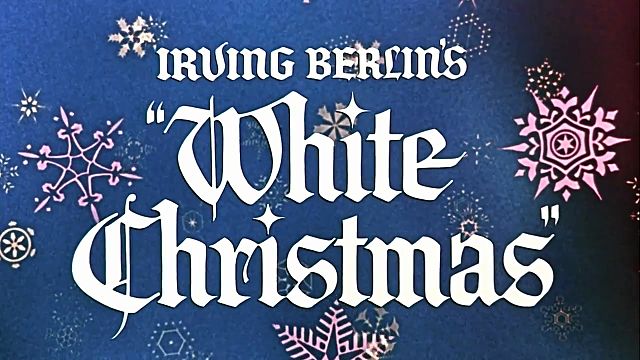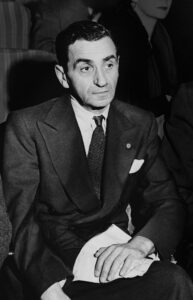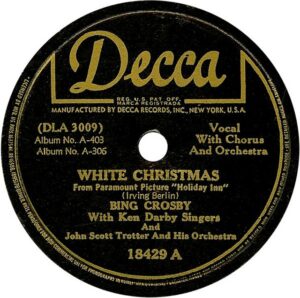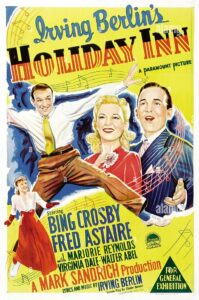May 9, 2023
The Story of Irving Berlin’s “White Christmas”

It’s December 1942. American soldiers find themselves spending yet another holiday overseas at the war’s front. The men sit around, some playing cards, some reading letters from their loved ones back home, and others try to keep busy. This Christmas is certainly different from the warm, joyous ones they’re used to. They are missing out on all their favorite Christmas traditions, but there is a job to do. The least they can do is spend the holiday in each other’s presence. Suddenly the familiar, strong and smooth baritone voice of Bing Crosby comes on singing Irving Berlin’s “White Christmas.” The soldiers are quiet as they listen to the wistful tune over the air waves. Each listens and reminisces about their homes and families, dreaming of the Christmases they used to know and long for now more than ever. There is something about this particular song. Maybe it’s the simple melody, carefully constructed by its composer, Irving Berlin. Then again, maybe it’s the lyrics that speak directly to the hearts of so many at this particular time of year. Perhaps it is a combination of the two, but either way “White Christmas” has come to be known, recorded, and loved by so many.
The story of the song “White Christmas” first began in May of 1940. Irving Berlin, a well-known and well-respected American composer by this time, wanted to expand his horizons as an artist. He had worked providing songs for various films, but he wanted to do more than just contribute songs for other people’s movies. He wanted to come up with movie concepts that were specifically designed to sell his old songs, as well as new ones specifically crafted to go with whatever film he would be working on. Irving Berlin dreamt of seeing his name above the title for a film’s billing. He craved that simple apostrophe claiming a film as his own: “Irving Berlin’s __.” So, in May 1940, he began talking with movie director Mark Sandrich about starting a film project together.1 The pair had already worked together on two Fred Astaire and Ginger Rogers pictures at RKO in the 1930s, and by all accounts they had clicked immediately.2 Perhaps inspired by the work he used to do on Broadway, Irving Berlin had an idea for a revue based around the holidays. Sandrich instantly suggested that this film would be perfect for Bing Crosby.3 Sandrich was now over at Paramount as a prominent producer-director there, and he liked what he was hearing from Berlin. On May 23, 1940 Sandrich wrote back to Berlin with good news: William Le Baron, head of production at Paramount, liked the idea and promised them that anything on the lot would be at their disposal, including Crosby. At the time, Bing Crosby held a vastly prominent position in radio, records, and films. His star power and name recognition rated him tenth among stars in his ability to get people to buy tickets from simply seeing his name displayed on the marquee. His name alone would provide an audience, but Berlin had big aspirations for this project. He wanted to add Fred Astaire to his cast list. Having directed five of his films already, Sandrich spoke to Astaire about the project and reported back that Fred was “very hot about the setup.” This was going to be a huge hit indeed. As Hollywood Reporter put it, “That big four of delightful filmusicals—Irving Berlin, Mark Sandrich, Bing Crosby and Fred Astaire—join forces in the cause of a sparkling entertainment appropriately titled ‘Holiday Inn.’”4

Now that Berlin’s holiday revue was well underway, he needed to fill it with his music. While the composition of the tune for “White Christmas” dates back as early as August 1938, a lead sheet didn’t come into existence until January 8, 1940. After an apparently productive weekend, Berlin flew into his 799 Seventh Avenue office and told his musical secretary of many years, Helmy Kresa “I want you to take down a song I wrote over the weekend. Not only is it the best song I ever wrote, it’s the best song anybody ever wrote.”5 He wrote to George Cohen, his Hollywood lawyer, that “there is already one song done for the picture. It is called ‘White Christmas’ and it is to be a main part of the contract.”6 Even in the early stages of Holiday Inn, Berlin knew that “White Christmas” and Bing Crosby would be essential to its success. Both Berlin and Crosby were signed long before other male and female costars were signed on. In fact, Irving Berlin wrote once more to Cohen in January 1941 that he was “not willing to sign any contract before they have signed Crosby.” Finally, Paramount signed the star and things progressed for Holiday Inn.7
By August, Berlin had ten songs set to take stage in his soon-to-be Hollywood block buster. He ventured into Bing’s dressing room to run the songs by him, almost as if to get his blessing for each one. As the star who would record most of the songs, Irving Berlin took Crosby’s opinion seriously. There was a nervous anxiety felt by Berlin that grew within him as he placed each of his personally-crafted tunes before Crosby. As each song was played to him, Bing nodded his quiet approval. But when he did “White Christmas,” Bing Crosby became invigorated, insisting, “Irving, you won’t have to worry about that one.”8
With contracts signed and songs approved, Holiday Inn was set up for success. Irving Berlin worked closely with director Mark Sandrich to hammer out the details and problems with the future film. The stars and music were a sure success, but the two were struggling to compose a sound plot. Berlin was coming to terms with the fact that the “revue format was considered unsuitable for the screen.”9 He had done a lot of work for Broadway shows, which didn’t typically rely too heavily on the most well thought-out plot. But he had a vision for what he wanted the film to be, and after a long career in songwriting, he took advantage of his adaptability.10 He knew he wanted the movie to follow Bing Crosby’s character, “an easygoing fellow who works only on holidays,” as Berlin put it.11 The goal was to find a way to work in as many holidays as possible. “Easter Parade” was one of his repurposed songs from earlier film projects. Some new songs added to his catalog specifically for the film Holiday Inn were “Happy New Year Blues,” “Plenty to Be Thankful For,” “This Is a Great Country,” and of course “White Christmas.” He ultimately found a way to fit in Easter, the Fourth of July, New Years, Lincoln’s Birthday, Valentine’s Day, Thanksgiving, and Christmas. He did this by making Crosby’s character a retired performer who bought a farm in order to live that charmed, simple life. After the whole farm thing didn’t work out, he turned it into an inn that would be only open on holidays. Berlin knew how to craft a successful musical, so he knew the film needed a “two boys and a girl setup.”12 Enter Fred Astaire’s character, the show business friend who thinks Crosby’s character was crazy, yet who ends up hanging around long enough to take Crosby’s love interest as a dance partner. With the bones of a plot, outstanding music, and powerful stars, Holiday Inn was ready to take the country by storm.

While Irving Berlin and his colleagues were enjoying the anticipation of success for their film and for his accompanying catalog of music, a different type of anticipation was being felt by the country. World War II had becoming a global concern, and there was much tension in the United States. Americans had been largely isolationists, but in 1941, talk of war was the main concern on every American’s mind. But as of the fall of 1941, the United States was still not directly involved. It was late November or early December when Bing Crosby recorded the song “White Christmas” for use in Holiday Inn. At that moment in history, on December 7, 1941, news was received throughout the nation that the US naval base at Pearl Harbor had been attacked. War was no longer a question for Americans, but a surging reality and call to action. On December 24, Bing Crosby sang “White Christmas” on the Kraft Music Hall broadcast to America for the first time. What should have been known as a historical event for the song, given all the fame it would receive soon afterward, was barely noticed by a country experiencing the first Christmas season at war.13
Holiday Inn, starring Bing Crosby, Fred Astaire, Marjorie Reynolds, Virginia Dale, and Walter Abel, was released in August of 1942. Its success was obvious and it immediately became a Hollywood blockbuster for the fall of 1942. It was a national phenomenon in just a few short months. By the end of November, more than 600,000 records were sold and over a million copies of sheet music were produced, distributed, and sold. The film was a hit and so was its prized song, “White Christmas,” which was the longest-running song to ever be played on the weekly radio show “Your Hit Parade.”14

The year 1942 saw the second Christmas for the United States in the midst of war. This state of affairs had a nationwide effect, both overseas at the front and back home. Obviously, many American soldiers and military personnel were a long way from home during that Christmas, due to war efforts. They were missing their families, and their families were missing them dearly, along with all the worry involved with a loved one fighting a war. This particular year saw an energy crisis in the US, particularly in the northeast and in the Ohio River Valley. Posters were put up urging Americans to save energy for the fight at the front and for all that was required in the industry of war production. For this reason, Christmas was literally less “bright” than usual. But it was also less bright in that it was not a typical holiday season for most, throughout the world really. The lyrics of Berlin’s “White Christmas” seemed to strike a chord with the whole nation. His lyrics evoking a nostalgic longing for the traditional Christmas memories and experience of past holidays resonated with Americans now more than ever. As one writer put it, “Berlin’s melancholy words gave voice to the heartfelt wishes of millions of Americans, at home and overseas, for a Christmas more joyous and brighter than the one they were about to celebrate.” The song famously sung by Bing Crosby soon became the unofficial anthem of the holiday season for the rest of the war.15
In his career as a Hollywood songwriter, Irving Berlin came to be recognized for the originality and sophistication of his songs. Thanks to “Irving Berlin’s Holiday Inn” as the marquee finally read, he enjoyed the recognition as a successful figure of Hollywood and of America. He found ways to expertly “place his songs in films so that their greater complexity was not a barrier to popularity.”16 And “White Christmas” was nothing if not popular and beloved by millions. The song went on to become one of the most widely recognizable and beloved Christmas songs of all time, with countless recordings by many talented and well-known artists. It somehow became a song of comfort and nostalgia to a country in the midst of war. In typical Irving Berlin fashion, he would return a decade later to the classic tune giving it a movie of its own: White Christmas yet again starring Bing Crosby to sing the beloved classic to America once more, and yet again holding the claim as “Irving Berlin’s White Christmas.”
- Todd Decker, “On the Scenic Route to Irving Berlin’s Holiday Inn (1942),” The Journal of Musicology 28, no. 4 (2011): 464, https://doi.org/10.1525/jm.2011.28.4.464 ↵
- James Kaplan, “What Is a War Song?,” in Irving Berlin, New York Genius (Yale University Press, 2019), 191, https://doi.org/10.2307/j.ctvrf8922.19 ↵
- James Kaplan, “What Is a War Song?,” in Irving Berlin, New York Genius (Yale University Press, 2019), 191, https://doi.org/10.2307/j.ctvrf8922.19 ↵
- Todd Decker, “On the Scenic Route to Irving Berlin’s Holiday Inn (1942),” The Journal of Musicology 28, no. 4 (2011): 466, https://doi.org/10.1525/jm.2011.28.4.464 ↵
- James Kaplan, “What Is a War Song?,” in Irving Berlin, New York Genius (Yale University Press, 2019), 192, https://doi.org/10.2307/j.ctvrf8922.19 ↵
- James Kaplan, “What Is a War Song?,” in Irving Berlin, New York Genius (Yale University Press, 2019), 193, https://doi.org/10.2307/j.ctvrf8922.19 ↵
- James Kaplan, “What Is a War Song?,” in Irving Berlin, New York Genius (Yale University Press, 2019), 193, https://doi.org/10.2307/j.ctvrf8922.19 ↵
- James Kaplan, “What Is a War Song?,” in Irving Berlin, New York Genius (Yale University Press, 2019), 197, https://doi.org/10.2307/j.ctvrf8922.19 ↵
- James Kaplan, “What Is a War Song?,” in Irving Berlin, New York Genius (Yale University Press, 2019), 195, https://doi.org/10.2307/j.ctvrf8922.19 ↵
- Charlotte Greenspan, “Irving Berlin in Hollywood: The Art of Plugging a Song in Film,” American Music 22, no. 1 (2004): 40, https://doi.org/10.2307/3592965. ↵
- James Kaplan, “What Is a War Song?,” in Irving Berlin, New York Genius (Yale University Press, 2019), 196, https://doi.org/10.2307/j.ctvrf8922.19 ↵
- James Kaplan, “What Is a War Song?,” in Irving Berlin, New York Genius (Yale University Press, 2019), 196, https://doi.org/10.2307/j.ctvrf8922.19 ↵
- James Kaplan, “What Is a War Song?,” in Irving Berlin, New York Genius (Yale University Press, 2019), 202, https://doi.org/10.2307/j.ctvrf8922.19 ↵
- David J. Bercuson and Holger H. Herwig, “White Christmas,” in Long Night of the Tankers, Hitler’s War Against Caribbean Oil (University of Calgary Press, 2014), 197, http://www.jstor.org/stable/j.ctv5rdzf3.16. ↵
- David J. Bercuson and Holger H. Herwig, “White Christmas,” in Long Night of the Tankers, Hitler’s War Against Caribbean Oil (University of Calgary Press, 2014), 197, http://www.jstor.org/stable/j.ctv5rdzf3.16 ↵
- Charlotte Greenspan, “Irving Berlin in Hollywood: The Art of Plugging a Song in Film,” American Music 22, no. 1 (2004): 48, https://doi.org/10.2307/3592965. ↵
Tags from the story
Bing Crosby
Holiday Inn
Irving Berlin
White Christmas
Andrew Ponce
This article in particular hits closer to home for me, a reader, since I grew up with this play/ film. I later came to realize that although I have seen “White Christmas” several times, there may have been some individuals who have not and know nothing about this story. The author of this article does an amazing job at articulating the story and background of “White Christmas” and explaining it to the reader in a way that is engaging. The additional youtube clip towards the end is also a different engaging technique that I find very effective. Great job!
14/05/2023
2:10 pm